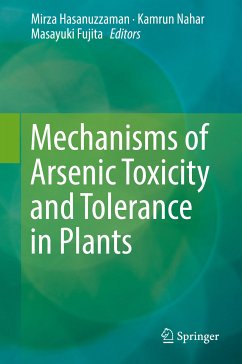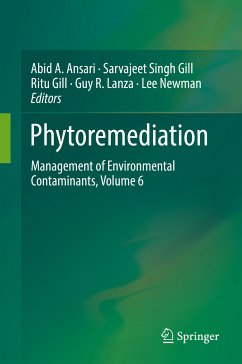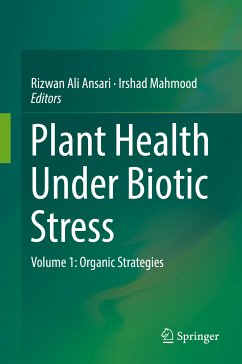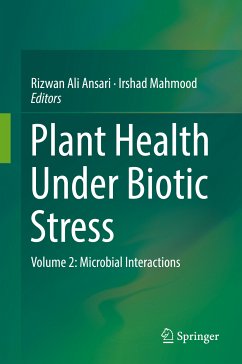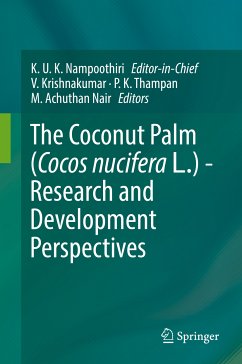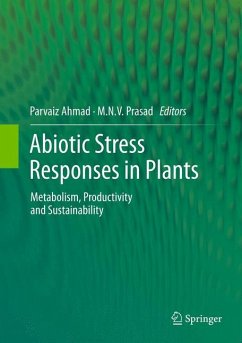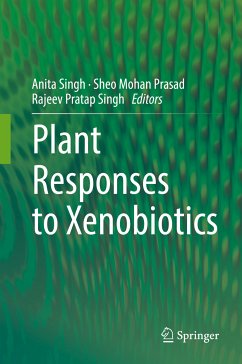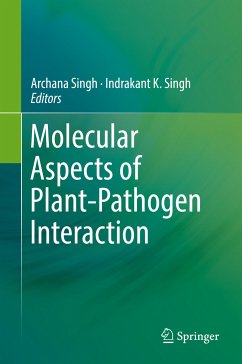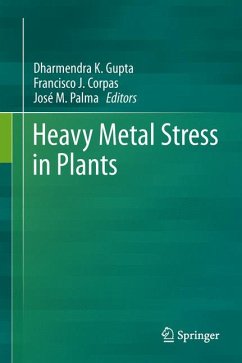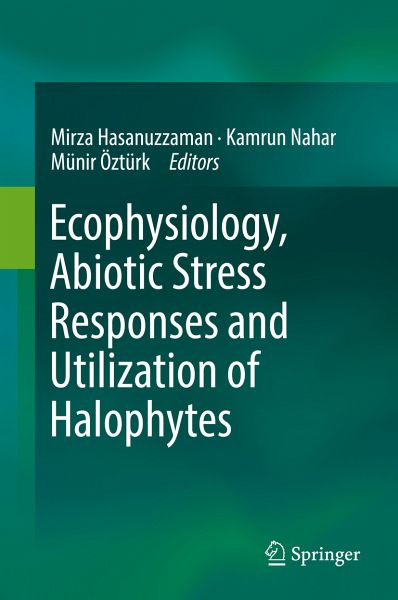
eBook, PDF
Ecophysiology, Abiotic Stress Responses and Utilization of Halophytes (eBook, PDF)

PAYBACK Punkte
36 °P sammeln!





The first-ever book on halophytes and their potential uses
Highlights the latest developments in halophyte biology, ecology and potential applications
Provides essential information for researchers and practitioners alike
Dieser Download kann aus rechtlichen Gründen nur mit Rechnungsadresse in A, B, BG, CY, CZ, D, DK, EW, E, FIN, F, GR, HR, H, IRL, I, LT, L, LR, M, NL, PL, P, R, S, SLO, SK ausgeliefert werden.
Dr. Mirza Hasanuzzaman is a Professor of Agronomy at Sher-e-Bangla Agricultural University in Dhaka, Bangladesh. He completed his Ph.D. on 'Plant Stress Physiology and Antioxidant Metabolism' at Ehime University, Japan with a scholarship from the Japanese government. Later, he completed his postdoctoral research at the Center of Molecular Biosciences, University of the Ryukyus, Japan, as a recipient of a Japan Society for the Promotion of Science (JSPS) postdoctoral fellowship. He was also awarded the Australian Government's Endeavour Research Fellowship for postdoctoral research as an Adjunct Senior Researcher at the University of Tasmania, Australia. Dr. Hasanuzzaman's current work is focused on the physiological and molecular mechanisms of environmental stress tolerance (salinity, drought, flood, and heavy metals/metalloids). He has published over 80 articles in peer-reviewed journals, edited six books and written 30 book chapters on important aspects of plant physiology,plant stress tolerance, and crop production. He is an editor and reviewer for more than 50 peer-reviewed international journals and was a recipient of the 'Publons Peer Review Award 2017.' He has been honored by various authorities for to his outstanding contributions to research and education, and received the World Academy of Science Young Scientist Award (2014). Dr. Kamrun Nahar is an Associate Professor, Department of Agricultural Botany at Sher-e-Bangla Agricultural University, Dhaka, Bangladesh. She completed her Ph.D. on 'Environmental Stress Physiology of Plants' at Ehime University, Japan on a Japanese Government (MEXT) Scholarship in 2016. Dr. Nahar has been involved in research with field crops emphasizing stress physiology since 2006. She has completed several research projects funded by the Sher-e-Bangla Agricultural University Research System and the Ministry of Science and Technology (Bangladesh). Dr. Nahar has published numerous articles in peer-reviewed journals and books, including 50 articles and chapters related to plant physiology and environmental stresses with Springer, Elsevier, CRC Press, Wiley, etc. She is involved in editorial activities and serves as a reviewer for international journals. Further, she is an active member of over 20 professional societies. Dr. Münir Öztürk (Ph.D.) completed his M.Sc. degree at Jammu & Kashmir University, Kashmir, and his Ph.D. & D.Sc. at Ege University Izmir, Turkey. Over the last 50 years, he has served in different positions at Ege University. Dr. Öztürk was elected as the "Vice President of the Islamic World Academy of Sciences" in 2017, and has received fellowships from the Alexander von Humboldt Society, Japanese Society for Promotion of Science, and National Science Foundation (USA). He is the Founding Director of the Centre for Environmental Studies at Ege University and has worked as a Consultant Fellow, Faculty of Forestry, Universiti Putra Malaysia, Malaysia and as Distinguished Visiting Scientist, ICCBS, Karachi University, Pakistan. His main fields of scientific interest are Plant Eco-Physiology; Medicinal and Aromatic Plants, Conservation of Plant Diversity; Biosaline Agriculture and Crops; Pollution and Biomonitoring. He has published 40 books, 50 book chapters, and more than 200 papers in prominent journals.
Produktdetails
- Verlag: Springer Nature Singapore
- Seitenzahl: 401
- Erscheinungstermin: 12. April 2019
- Englisch
- ISBN-13: 9789811337628
- Artikelnr.: 56249404
Für dieses Produkt wurde noch keine Bewertung abgegeben. Wir würden uns sehr freuen, wenn du die erste Bewertung schreibst!
Eine Bewertung schreiben
Eine Bewertung schreiben
Andere Kunden interessierten sich für
1) Gebundener Aktionspreis des Verlages. Die Ersparnis bezieht sich auf den gebundenen Preis, der außerhalb des Aktionszeitraums gilt.
| 2) Gebundener Einführungspreis des Verlages. Die Ersparnis bezieht sich auf den gebundenen Preis, der nach der Einführung gilt.
| 3) Gebundener Einführungspreis. Die Ersparnis bezieht sich auf den gebundenen Preis, der nach der Einführung gilt.
| 4) Die Ersparnis bezieht sich auf den gebundenen Preis, der außerhalb des Aktionszeitraums gilt.
| 5) Ersparnis im Vergleich zum gebundenen Preis für die Originalausgabe mit höherwertiger Ausstattung.
| 6) Ersparnis im Vergleich zum niedrigsten Preis der vergangenen 30 Tage.
| 7) Ersparnis im Vergleich zum Preis der gedruckten Ausgabe (broschiertes Buch).
| 8) Ersparnis im Vergleich zum Preis der gedruckten Ausgabe (broschiertes Schulbuch)
| 9) Ersparnis im Vergleich zum Preis der gedruckten Ausgabe (Buch mit Leinen-Einband)
| 10) Ersparnis im Vergleich zum Preis der gedruckten Ausgabe (gebundenes Buch)
| 11) Ersparnis im Vergleich zum Preis der gedruckten Ausgabe
| 12) Ersparnis im Vergleich zum vorherigen gebundenen Ladenpreis
| 13) Ersparnis im Vergleich zur Audio-CD-Ausgabe
| 14) Ersparnis im Vergleich zur CD-Ausgabe
| 15) Ersparnis im Vergleich zur deutschen Hardcover-Ausgabe
| 16) Ersparnis im Vergleich zur deutschen Taschenbuch-Ausgabe
| 17) Ersparnis im Vergleich zur früheren unverbindlichen Preisempfehlung (UVP) des Herstellers
| 18) Ersparnis im Vergleich zur Summe der vorherigen gebundenen Einzelpreise der im Sammelband/Schuber enthaltenen Bücher.
| 19) Ersparnis im Vergleich zur unverbindlichen Preisempfehlung (UVP) des Verlags der Originalausgabe
| 20) Ersparnis im Vergleich zur unverbindlichen Preisempfehlung (UVP) des Herstellers
| 21) Sonderausgabe. Ersparnis im Vergleich zum gebundenen Preis für die Originalausgabe mit zum Teil höherwertiger Ausstattung
| 22) Ersparnis im Vergleich zum früheren gebundenen Preis
| 23) Ersparnis im Vergleich zum niedrigsten Preis der vergangenen 30 Tage
| 24) Ersparnis im Vergleich zum niedrigsten Preis der vergangenen 30 Tage
| 25) Frühere unverbindliche Preisempfehlung des Herstellers
Alle Preise in Euro und inkl. der gesetzl. MwSt. | Innerhalb Deutschlands liefern wir preisgebundene Bücher versandkostenfrei. Weitere Informationen: bitte hier klicken
Bewertung schreiben
BEWERTUNGSFORMULAR
Schließen
Support
Bitte wähle dein Anliegen aus:
Rechnungen
Bestellstatus
Retourenschein
Storno
Sollte dein Anliegen nicht dabei sein, findest du weitere Auskünfte zu deinen Fragen auf unseren Serviceseiten.
Schließen


